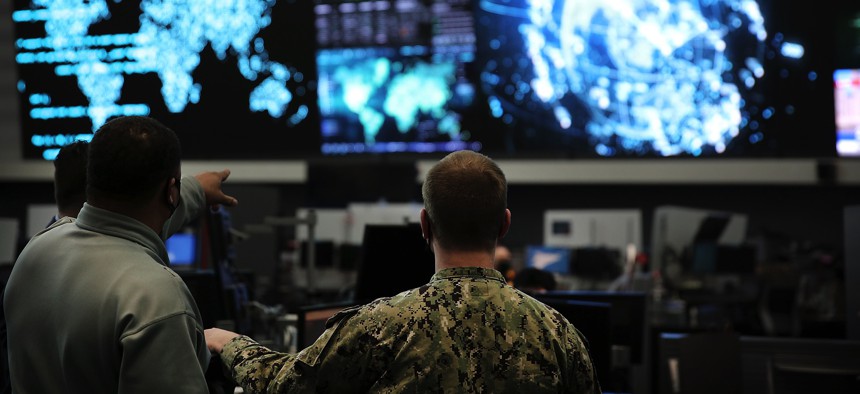DISA’s Plea to Industry: Bring Us Battlefield-Ready Tech

U.S. Cyber Command members work in the Integrated Cyber Center, Joint Operations Center at Fort George G. Meade, Md., April. 2, 2021. Photo by Josef Cole
The Pentagon’s IT agency also wants help wringing more performance out of its existing gear.
The Pentagon’s lead IT agency wants to do more buying and less making, a key leader says.
“We want to communicate with our industry partners as much as possible because we will rely on them to deliver capability that the warfighter needs today and we don't want to necessarily have to develop it,” said Don Means, who leads the Defense Information Systems Agency’s Operations and Infrastructure Center. “We really want to adopt and evolve existing capabilities as much as possible."
Means talked with Defense One ahead of the agency’s annual Forecast to Industry event held on Monday in Baltimore, Md.
He stressed that such capabilities must integrate cybersecurity and supply chain risk management. And besides seeking new tech at the industry day, the goal is to get feedback on how to best maximize what DISA has already bought “so I can take the capability that I purchased and use the maximum effect.”
The agency did some major reorganizing last year, creating new centers such as the Hosting and Compute Center and Means’ own Operations and Infrastructure Center.
Over the past six months, Means’ center has been looking for best practices from commercial partners, including how to better share cyber best practices to cyber information. But it has also worked to improve connectivity in the Pacific and support efforts in Ukraine.
Global connectivity and the Pacific
The center has been helping U.S. Indo-Pacific Command improve its ability to communicate across its vast region and especially in the event of a confrontation with China, Means said.
Those challenges also drive DISA’s desire to buy commercially-ready tech, Means said.
The agency “is relying on industry as a critical partner to deliver solutions,” he said. “We don't want to have to develop them when the industry is already doing them” because that means capabilities can be delivered faster.
DISA’s operations center got busier than expected after Russia invaded Ukraine in February, coordinating and delivering cybersecurity personnel and tools to Europe while keeping up its Pacific work.
“The fight in cyber is global,” Means said. “If it rings, dings, or chimes, it is supported by Operations in some way, shape, or form. Hundreds of millions of cyber attacks [are] defended per day.”
Then he said: “You can't take your eye off the ball in any area of operation. And then you have to be willing to pivot to support no matter what's going on in the world. The next crisis might be somewhere in SOUTHCOM, it might be in INDOPACOM, but we have to be prepared and flexible.”
For the past year, DISA’s operations center has worked to make its capabilities more resilient, secure, and flexible, while leaning on industry partners. For the year ahead, Means said, the goal is to “continue to perfect operations. We've done a lot but there's still a lot to do.”
$15 billion in contracts—and counting
DISA’s operations center has had a number of major contracts and shifts.
Leidos won the $11.5 billion Defense Enclave Services contract, which helps with network modernization for other defense agencies and field activities called the Fourth Estate, in February. Since then, Means said, DISA has been able to “raise the bar for security, standardize the campus environment across all the defense agencies and field activities” and “provide a more mobile portable environment” as part of the agency’s Fourth Estate Network Optimization Plan.
The contract was key because it helps consolidate contracts into a single vehicle for IT-service-desk needs. “It's narrowing it down to one contract, one secret environment, one unclassified environment, a unified global Help Desk to provide high-quality support across the board with the security that we need across the entire Fourth Estate,” Means said.
So far, DISA has finished network optimization for the Defense Technical Information Center and the Defense POW/MIA Accounting Agency. Up next: the Defense Contract Management Agency, Defense Manpower Data Center, and the Defense Media Activity.
Last year, DISA began moving users to the $4.4 billion Defense Enterprise Office Solutions, or DEOS, program, which offers cloud-based productivity tools like email and messaging. Since then, it’s been figuring out how to use the capability beyond offices and on the battlefield where connectivity may be lacking or spotty.
“It's broader than just an office and boardroom capability,” Means said. “It facilitates decision making, command and control, collaboration—and even though a Marine may not have a mobile device on the battlefield to get into DEOS, certainly they're supported by this.”
The Marine Corps requested the capability earlier this year. And DISA is working to make sure users can share across the department.
DISA aims to enable DEOS users to collaborate on classified information sometime next year, Means said.
NEXT STORY: DOE Wants to Bridge Their 'Valley of Death'






